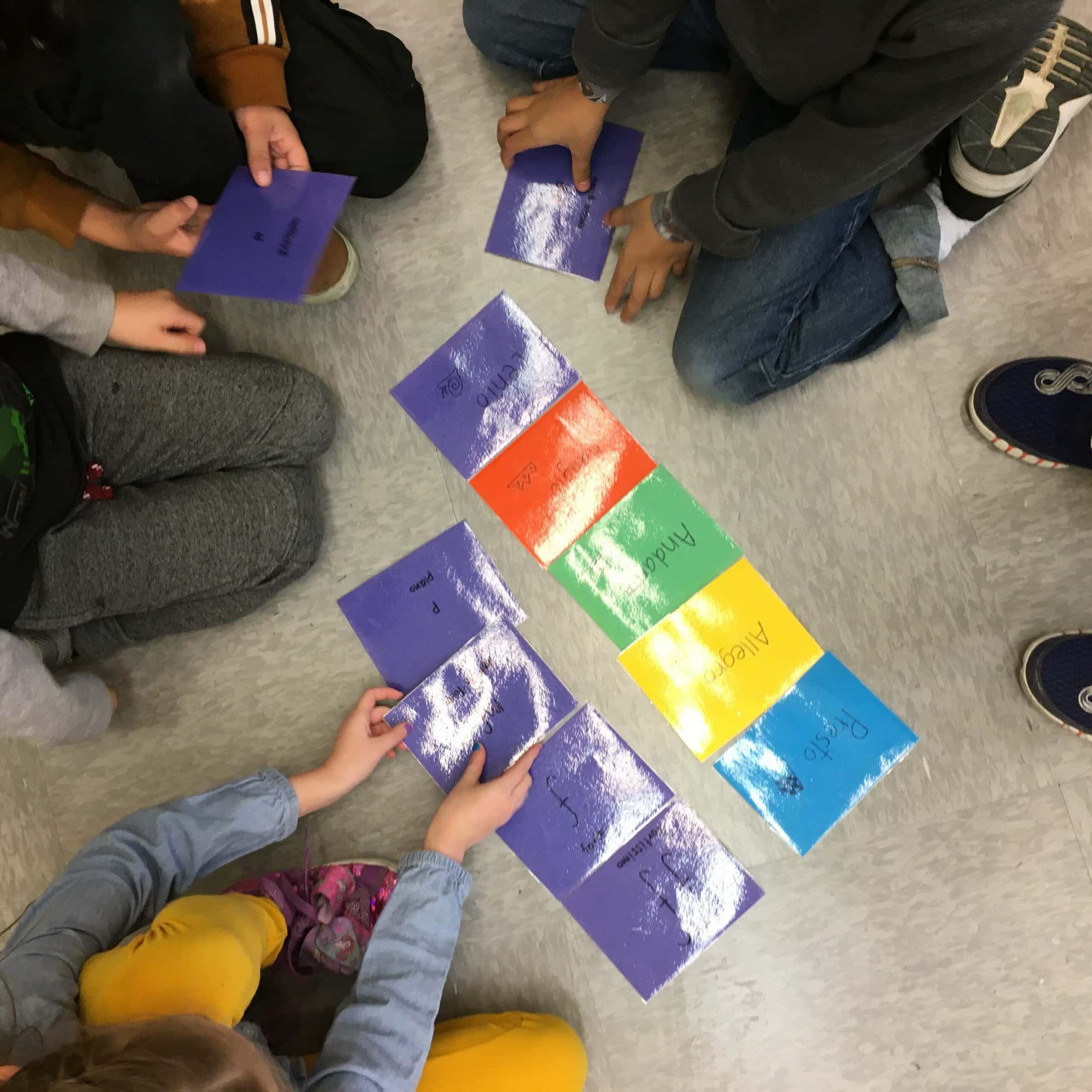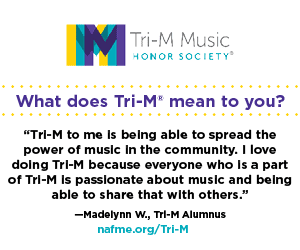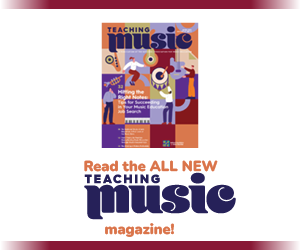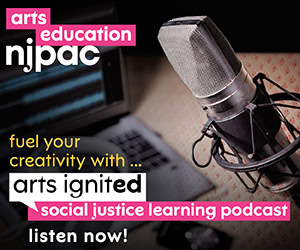NAfME BLOG
Assessing the Standards: An Exploration of the Respond Model Cornerstone Assessment

/ News Posts / Assessing the Standards: An Exploration of the Respond Model Cornerstone Assessment
Assessing the Standards
An Exploration of the Respond Model Cornerstone Assessment
By NAfME Member Emily Hatch
This article first appeared in the April 2022 issue of Journal of General Music Education.
The National Core Arts Standards include Model Cornerstone Assessments to give teachers an idea of how to assess the three artistic processes of Create, Respond, and Perform (National Core Arts Standards, 2014). In this column, I will explain the Model Cornerstone Assessment for the Respond process; discuss what students need to know in order to succeed on the assessment; and explore ways for teachers to modify the assessment and use the data to refine their teaching.
Model Cornerstone Assessments (MCA) were created to be an individual measure of student achievement in each artistic process (Burrack and Parkes, 2018). They were piloted by teams of teachers across America and were modified based on feedback given by those teachers. I was part of the pilot team for the Respond assessment, and it was interesting to watch the assessment change based on the experiences of teachers implementing the assessment in classrooms. Over many cycles of implementation, the assessment got shorter and clearer as to what was expected from students and how to measure their learning with the included rubrics. Each MCA is contained within one document including all of the standards, assessment strategies, scoring devices, and printable worksheets needed to implement the assessment (National Association for Music Education, 2017).
Building Vocabulary
To be successful at the Respond MCA, students need to have a certain pre-knowledge of music. This is listed on the MCA for each sub-section’s assessment strategy. For instance, fifth grade students need to know the definitions of the elements of music and be able to identify those elements while listening to music. The first time I gave the MCA in my class as part of the pilot, I was dismayed to realize that my students didn’t actually have a working knowledge of elements of music. It was slightly discouraging to score my students’ work and realize that what I had been teaching did not prepare students to be successful with the Core Arts Standards. However, I recognized this as an opportunity to adjust my teaching in order to better align my classroom activities with what students needed to learn, and mined ideas from Reading and Writing instruction to help students build their music vocabulary.
I created a word wall in my classroom containing intentionally chosen elements of music. In order to help students learn the vocabulary in a lasting way, I added icons for each word and continuously model their use, along with giving students lots of chances for using movement to act out the concepts and practicing identifying those elements (Lemov, Driggs, and Woolway, 2016). I also put the words into students’ hands, creating individual sets of cards for students to sort and reference when listening to music (Cooper, Chard, and Kiger, 2006).
In kindergarten, students practice using the elements of music as we chant simple rhymes at different speeds and dynamic levels. Students love being the one to choose what element of music to use next. First graders sort elements of music into different categories such as tempo and dynamics. As students get older, more and more words are added to the wall, so now by the time they reach fifth grade and do the Respond MCA, they have a solid working knowledge of the elements of music and no longer struggle so hard to identify what they hear.
Modifying the MCA
The MCA was never designed to be a static, inflexible test. Instead, from its inception, it was created to be adaptable for each teacher’s different situation in terms of content and time, and protected the autonomy of teachers to select appropriate tasks for their specific students (Burrack and Parkes, 2018). Teachers can also choose what music gets used in the MCA, giving them the freedom to inspect their own biases and to choose culturally informed materials (Mellizo, 2020).
Many teachers are put off by the amount of writing required by the MCA. However, it is important to remember that this isn’t an assessment of writing ability. Instead of writing out answers, students can explain their thinking verbally to a teacher or use a program like Flipgrid or Seesaw to record their video or audio responses (Dunbar 2019). Teachers can also set up the MCA as a Google Form for students to select musical elements from a list or use technology like Nearpod or Peardeck to elicit student responses to the assessment, whether together in class or asynchronously (Dunbar 2018). I was even able to use the Respond MCA when teaching online during the pandemic.
The MCA can also be modified for different student learning needs using principles of Universal Design for Learning (Rapp 2014). Students might need alternative writing surfaces, or different sizes of text. Students could choose what kind of tool to write with. Students might benefit from using a graphic organizer or being able to circle elements of music off a list instead of writing them down. Students could even select their elements of music off the word wall or their personal ring of cards; select stickers off of a sheet pre-made with all of the elements of music; or illustrate their responses if you have a standard set of icons accompanying the vocabulary on your word wall.
Another helpful modification for all students is to use a sentence frame to begin their answers. For instance, in the fifth grade Respond MCA, students might be given the frame, “I think that Recording #__ was the best fit for the context because___.” Students also benefit from a clear expectation of the number of reasons in their answer. Perhaps students are expected to use two musical elements and one thing from their own experience to back up their answer.
Using the Data to Effect Change
After implementing and scoring the MCA, teachers can use the data to effect change in their classrooms. According to Richeme (2016), “When a teacher measures and assesses student learning, both teacher and student alter” (p. 286). Reflective teachers will consider how well their students were prepared to be successful on the assessment task and examine their teaching activities to see how they could better fit the standards. I have made many changes to my music classes as a result of student data provided by MCAs. Instead of perceiving the assessments as an evaluation of myself as a teacher and feeling like a failure when my students didn’t do well, I saw the data as a map guiding me towards more effective teaching of the standards.
“Instead of perceiving the assessments as an evaluation of myself as a teacher and feeling like a failure when my students didn’t do well, I saw the data as a map guiding me towards more effective teaching of the standards.”
Teachers will also consider whether students were given opportunities for feedback before taking the MCA. Was it used as a formative, building experience, or a summative, final look at student mastery? Hopefully students are given feedback to enhance their learning (Payne, et. al. 2019). My students have benefited from times when they did a practice MCA and then gave each other feedback on the quality of their answers. Students also benefit from doing an MCA in partners or small groups and being able to discuss their ideas.
In conclusion, I encourage you to try one of the Model Cornerstone Assessments if you haven’t already. Feel free to modify it to suit your time and your own instructional parameters. Use the data you gather to shape your teaching and to think about how you can change your instruction to better prepare students to succeed at the National Core Arts Standards.
References:
Burrack, F. and Parkes, K. A. Eds. (2018). Applying Model Cornerstone Assessments in K-12 Music: A Research-Supported Approach. Rowman & Littlefield: Lanham, MD.
Cooper, J. D., Chard, D. J., and Kiger, N. D. (2006). The Struggling Reader: Interventions that Work. Scholastic: New York, NY.
Dunbar, L. (2018). Using Technology to Assess in the Music Classroom. General Music Today*, 32(1), 38-40.
Dunbar, L. (2019). When Responses Cannot be Written Down: Video Submission Possibilities in the Music Classroom. General Music Today*, 32(3), 29-30.
Lemov, D., Driggs, C. and Woolway, E. (2016). Reading Reconsidered: A Practical Guide to Rigorous Literacy Instruction. Jossey-Bass: San Francisco, CA.
Mellizo, J. (2020). Music Education, Curriculum Design, and Assessment: Imagining a More Equitable Approach. Music Educators Journal, 106(4), 57-65.
National Association for Music Education. (2017). Music Model Cornerstone Assessment: Responding 5th Grade General Music.
National Coalition for Core Arts Standards. (2014). National Core Arts Standards. Dover, DE: State Education Agency Directors of Arts Education.
Payne, P. D., Burrack, F., Parkes, K. A., and Weslowski, B. (2019). An Emerging Process of Assessment in Music Education. Music Educators Journal, 105(3), 36-44.
Rapp, W. H. (2014). Universal Design for Learning in Action: 100 Ways to Teach All Learners. Paul H. Brookes Publishing: Baltimore, MD.
Richeme, L. K. (2016). Measuring Music Education: A Philosophical Investigation of the Model Cornerstone Assessments. Journal of Research in Music Education, 64(3), 274-293.
*General Music Today is now known as Journal of General Music Education.
About the author:
 Emily Hatch teaches PK-5 music for DoDEA. She is passionate about reimagining a music classroom to align with the National Core Arts Standards. Her research interests include social justice in music education; democratic education; and differentiated learning. She is an alumnae of Bowling Green State University where she studied Music Education, World Music, and Cross-Cultural and International Education. She lives with her family in South Korea where you can find her riding her bike to work every day.
Emily Hatch teaches PK-5 music for DoDEA. She is passionate about reimagining a music classroom to align with the National Core Arts Standards. Her research interests include social justice in music education; democratic education; and differentiated learning. She is an alumnae of Bowling Green State University where she studied Music Education, World Music, and Cross-Cultural and International Education. She lives with her family in South Korea where you can find her riding her bike to work every day.
Did this blog spur new ideas for your music program? Share them on Amplify! Interested in reprinting this article? Please review the reprint guidelines.
The National Association for Music Education (NAfME) provides a number of forums for the sharing of information and opinion, including blogs and postings on our website, articles and columns in our magazines and journals, and postings to our Amplify member portal. Unless specifically noted, the views expressed in these media do not necessarily represent the policy or views of the Association, its officers, or its employees.
June 21, 2022. © National Association for Music Education (NAfME.org)
Published Date
June 21, 2022
Category
- Standards
Copyright
June 21, 2022. © National Association for Music Education (NAfME.org)







